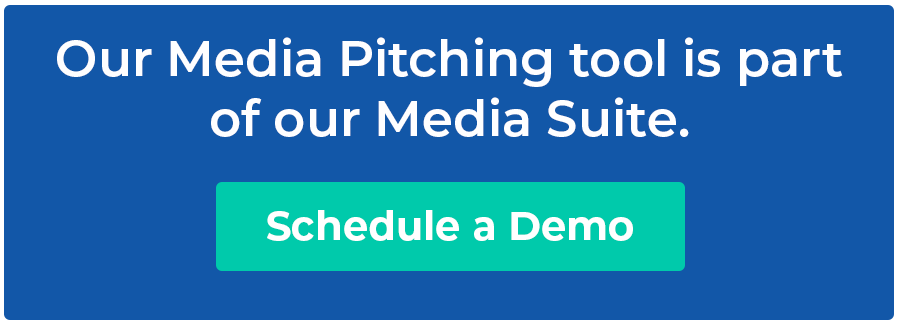
How to Grab the Attention of a Journalist
Capturing journalist attention is crucial in securing earned media mentions for your brand.
In this blog post, we share tips on how to get noticed by journalists, including:
- Learning how to craft personalized media pitches
- The importance of highlighting newsworthy aspects
- How to follow up like a true professional
- Building meaningful relationships with journalists
- Using multimedia to enhance your outreach efforts
By reading through our suggestions and applying them, you’ll notice an improvement in your ability to secure earned media coverage.

Personalize your pitch
Capturing and keeping journalist’s attention requires a strategic approach that goes beyond press release distribution.
Media pitches are the amplifier to your brand’s news. But, there’s a science to proper media pitching and it starts with personalization.
Once you’ve found the right media contacts using a Media Database you trust, personalize and customize your content to align with the recipient’s interests and past work.
By sending personalized media pitches instead of mass emails, you improve your chances of landing earned media coverage.
Here are some tips to consider:
- Research the journalists you’re targeting to understand their areas of interest, recent articles, and writing style.
- Tailor your pitch to their specific beats and expertise to demonstrate you value their time and insights.
- Address the journalist by name and include anecdotes from their past work to add a personal touch to your pitch.
- Craft a compelling opening statement to instantly grab the journalist’s attention. Your first few sentences are your chance to grab attention and make a strong first impression. Highlight the most newsworthy and unique aspect of your news first.
- Keep your pitch short and to the point. Try and keep it to 200 words or less.

Highlight newsworthy aspects
Highlighting the newsworthy aspects of your story is a must. Here are some examples.
Local Connection
One way to do this is by localizing your story.
You’re more likely to grab journalist attention by sharing stories with a local news angle.
Example: If you’re pitching a story about a new product, you could emphasize how it will benefit people in the journalist’s city or region.
Human Interest
Another way to make your story more newsworthy is to emphasize the human impact.
Journalists are also drawn to stories that have a personal element and that evoke emotions.
Showing how your story affects real people can increase your odds of getting media coverage.
Example: Let’s say you’re pitching a story about a new medical treatment. You could share a story of a patient that benefitted from the treatment.
Current Events
Current events and trends go hand-in-hand with newsworthiness.
Journalists are constantly looking for stories that are relevant to what’s happening around the world.
If you can connect the dots between your brand and current events/trends, you’ll get journalists’ attention.
Example: If you’re pitching a story about a new environmental regulation, you could share how it impacts businesses in the journalist’s industry.
Exclusivity
If you have exclusive information, share it in your pitch. Offer them something no one else has.
Exclusive content is a magnet for journalist attention.
Example: If you’re launching a new business, you’d share relevant details with the journalist prior to making a public announcement. In this instance, you could embargo the press release.
Quantify Impact
The impact of your news is something journalists are interested in.
If you can quantify and put a number on the impact of your story, the better off you’ll be in earning media coverage.
Example: If you’re pitching a story about a new study, you could share the number of participants and the findings.
Following these tips will put you in a better position to grab the attention of a journalist and getting your story published.
Follow up Like a Pro
Following up with journalists is a crucial step in the pitching process. Here are a few tips to follow up like a pro:
Thank Them
Begin by thanking the journalist for their time and consideration. Express your gratitude for their attention to your pitch, even if they ultimately decide not to pursue the story. A simple “thank you” can go a long way in building rapport and leaving a positive impression.
Give it Time
Send a follow-up email or make a follow-up call a few days after your initial media pitch.
This shows your continued interest in the story and that you value their time and expertise.
However, make sure not to be overly persistent or pushy, as this can have a negative effect.
If the journalist doesn’t respond to your initial email, you can follow up once or twice at the most.
Add to Your Pitch
When following up, provide any additional information or materials that may be relevant to the story.
This could include links to previous articles, data, or multimedia that support your pitch.
Be sure to present this information in a concise and organized manner to make it easy for the journalist to digest.
If the journalist ultimately decides not to pursue the story, don’t be discouraged.
Use the feedback you receive to refine your pitch and approach for future opportunities.
Make multimedia your ally
Multimedia can be a powerful tool in attracting attention.
High-quality images, videos, and infographics, can make your story more visually appealing and easier to understand.
When choosing images, be sure to select high-quality, relevant images that are free of copyright restrictions.
Videos can be even more effective.
You can use them to tell your story in a more dynamic and engaging way. When sharing videos, make sure they’re short and to the point.
Finally, infographics can present complex information in an easily digestible manner.
You can use them to illustrate trends, share statistics, and amplify other data.
When creating infographics, be sure to use clear and concise visuals and to avoid overcrowding them with information. Don’t forget to add your brand’s logo!
Newswire Media Suite
Creating and nurturing journalist relationships is imperative for your brand’s short- and long-term success.
Our Media Outreach Suite has all the tools you need in one platform. These tools include Media Database, Media Pitching, Media Monitoring, Media Room, and Press Release Distribution.
Fill out the form below to schedule a demo.










